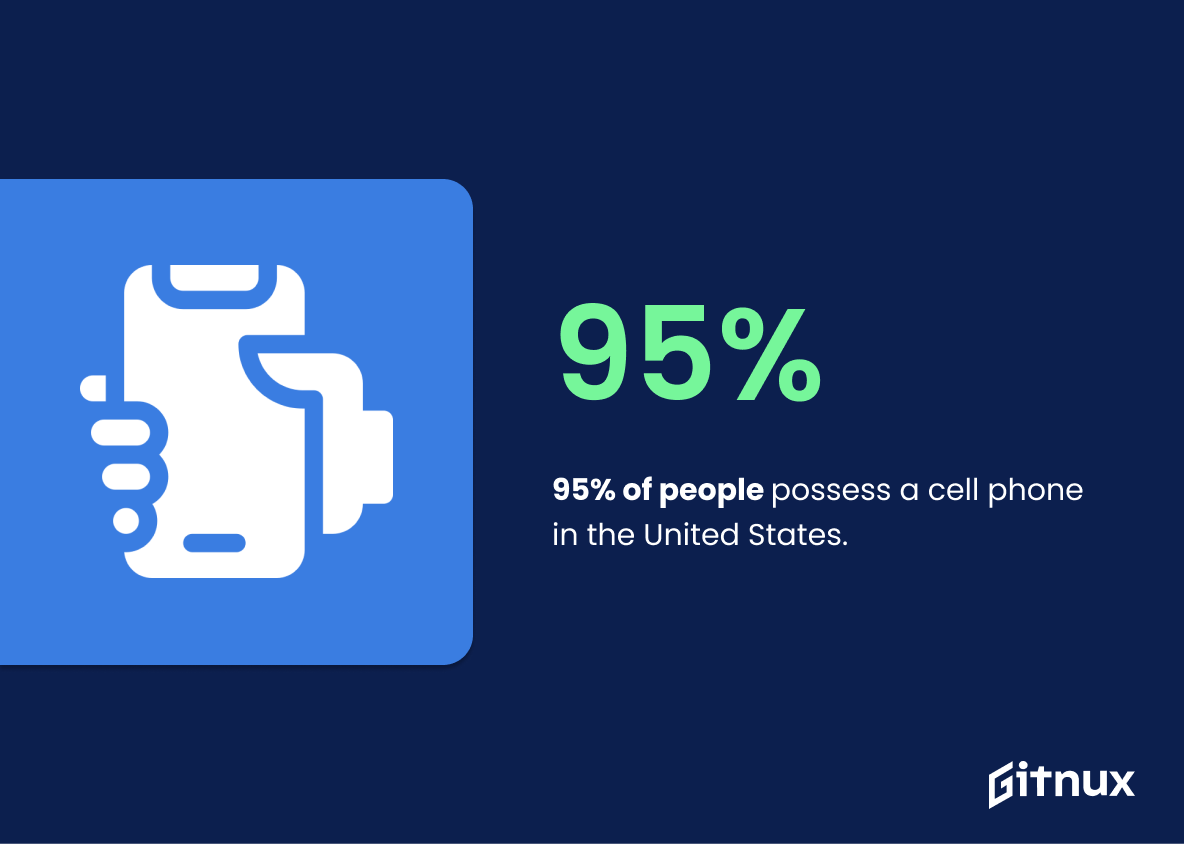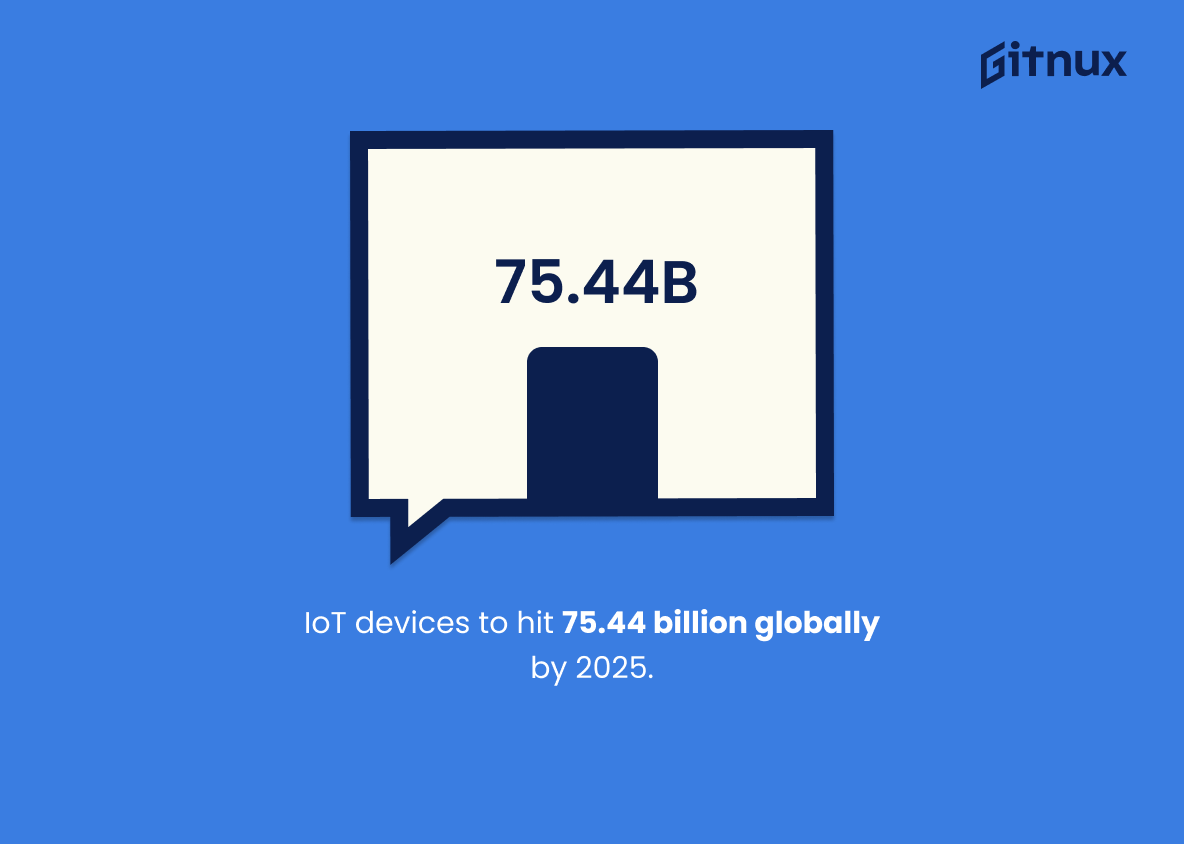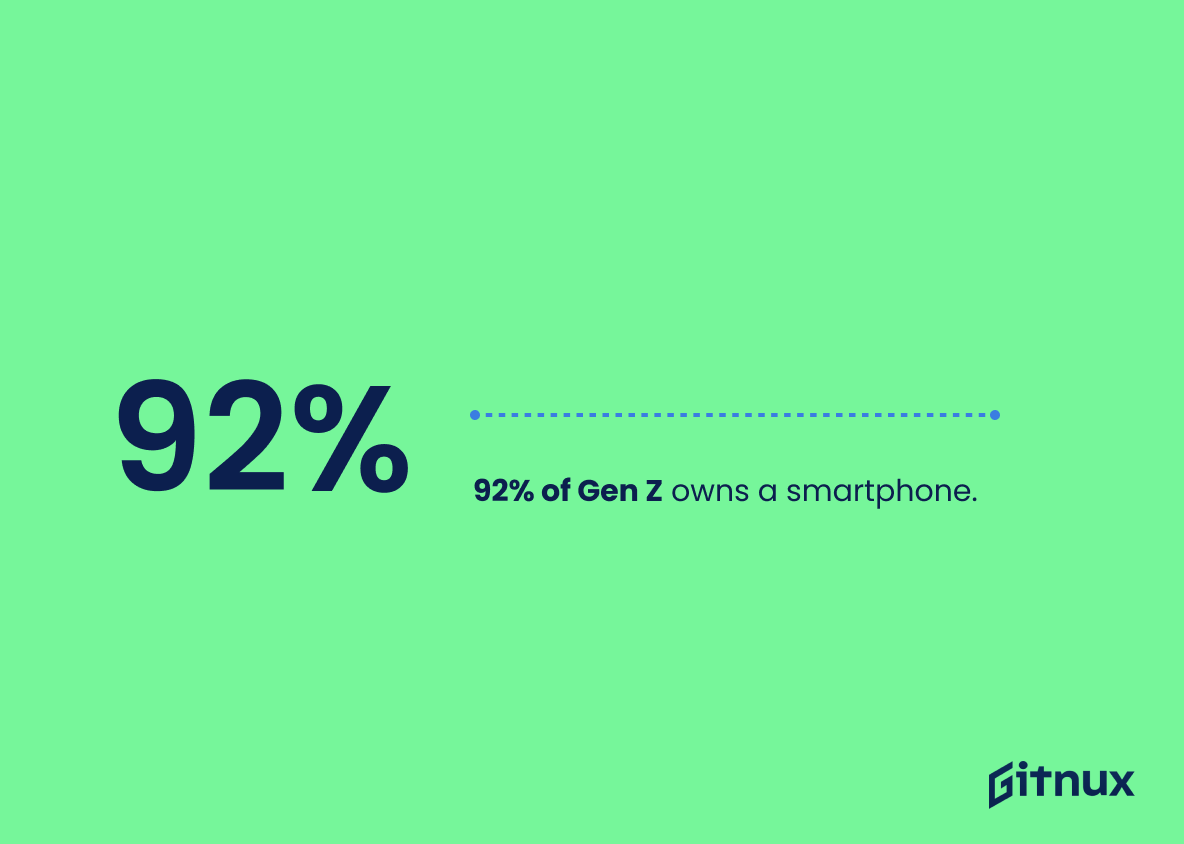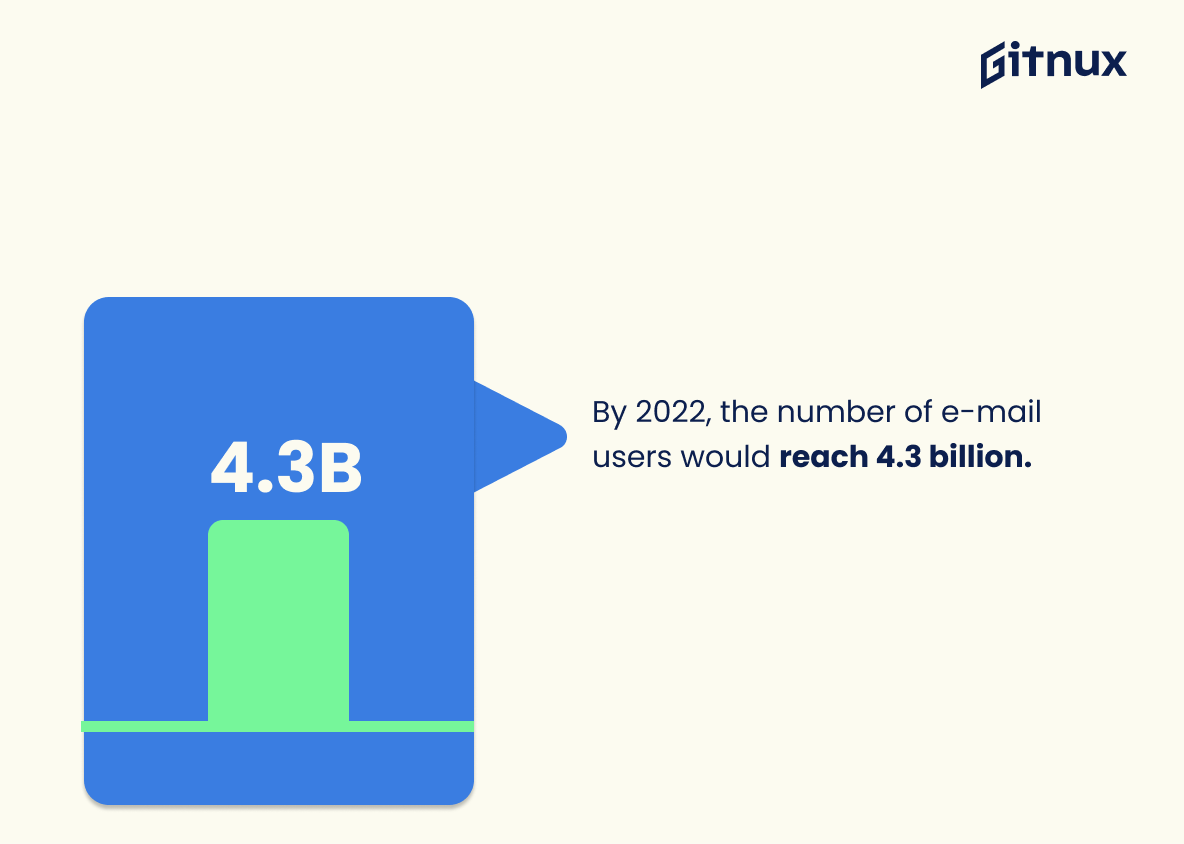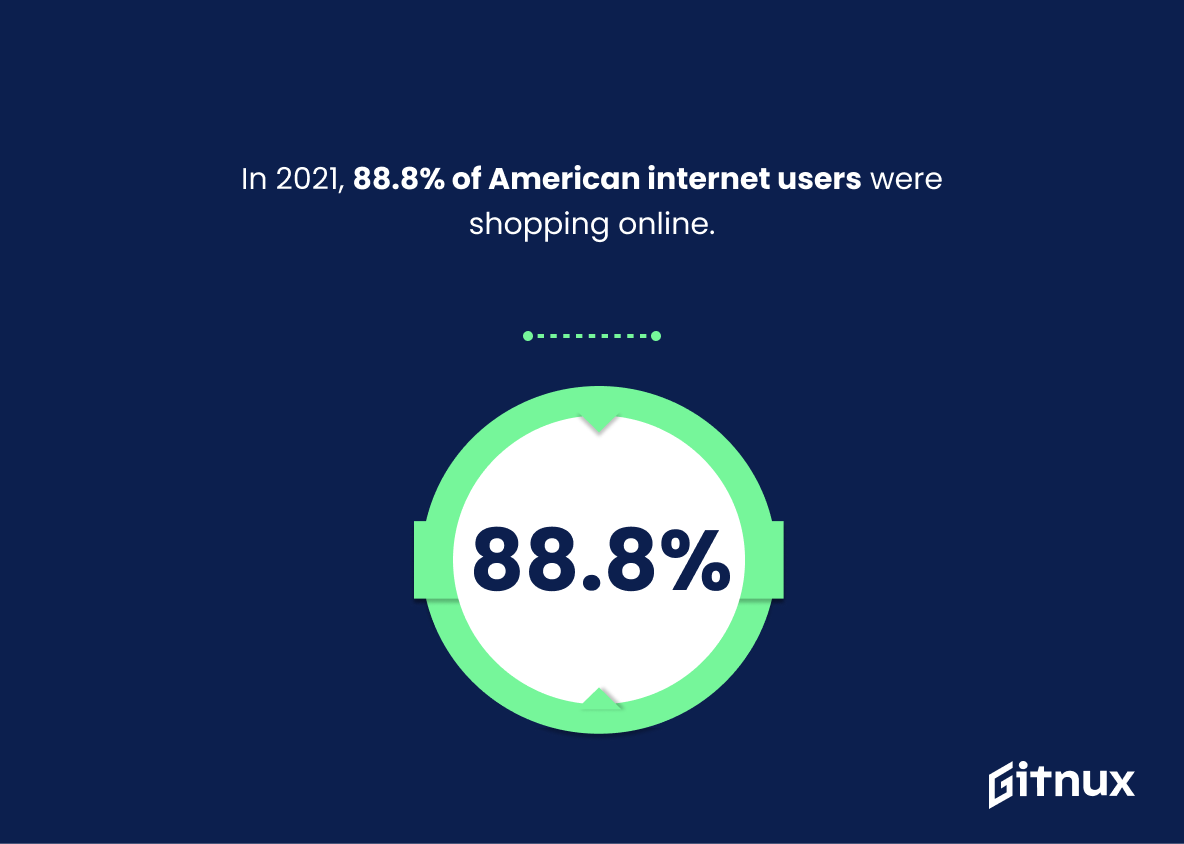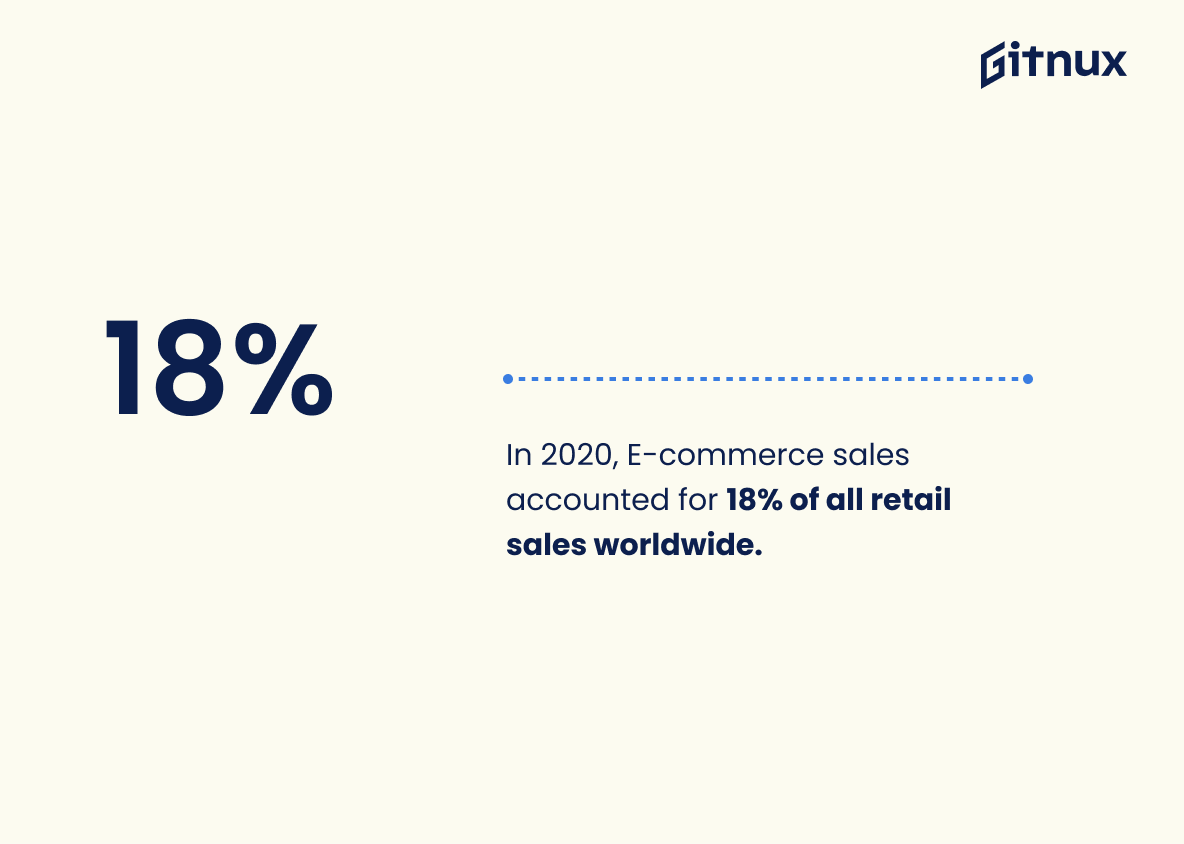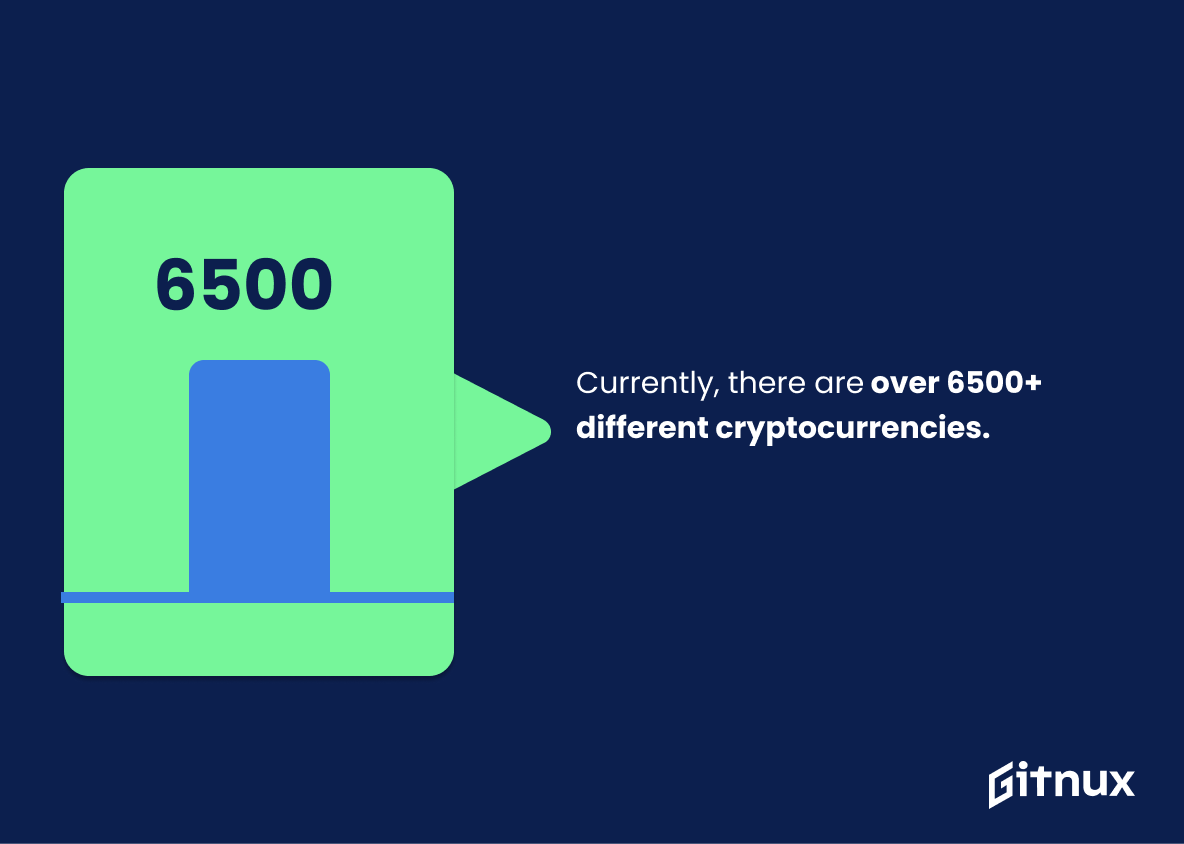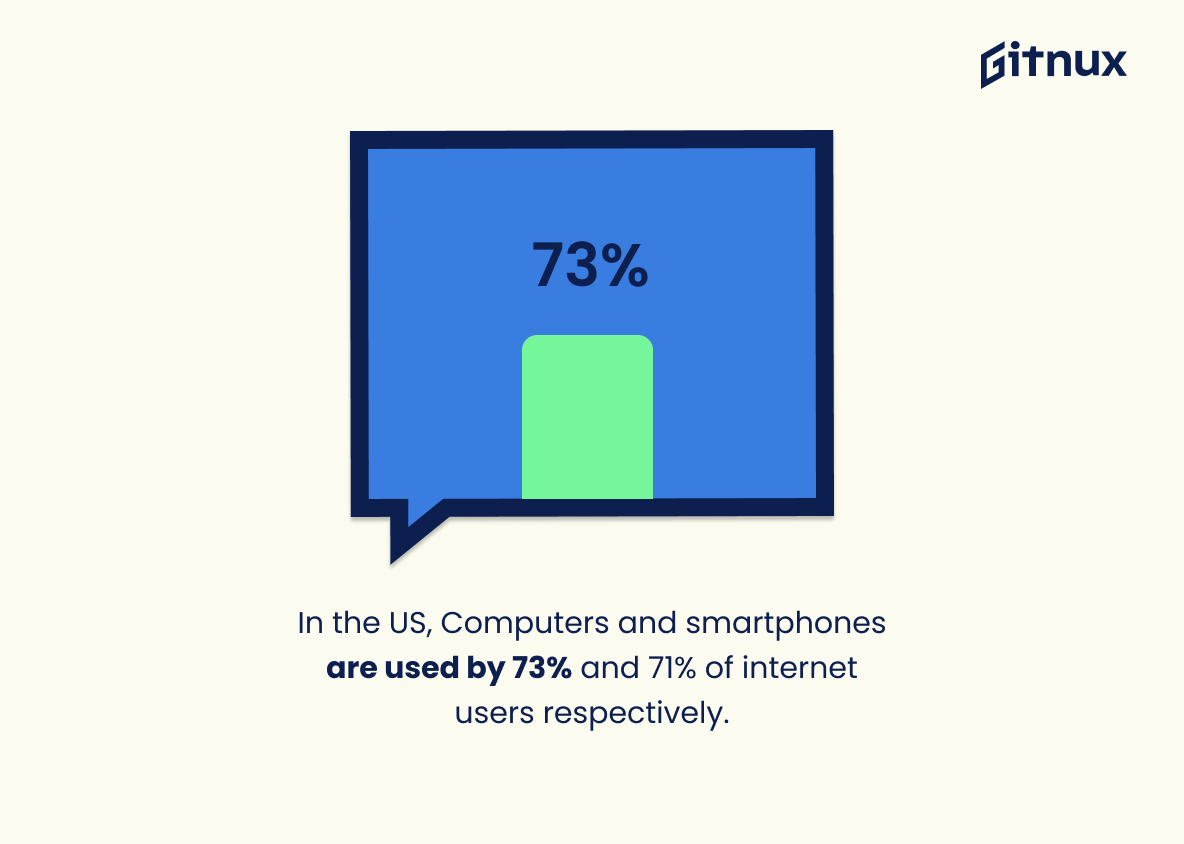In this constantly evolving digital world, technology has become an incredibly integral part of our lives. Whether it’s communication, healthcare, education or business, we are surrounded by cutting-edge technological advancements every single day. The effects of these advancements are so profound that they invariably shape our lifestyle and our way of thinking. In this blog post, we’ll delve into intriguing and eye-opening statistics about the use of technology, revealing the significant impact it has on global societies and industries. Be ready to embark on an uncharted journey that reveals just how much we rely on technology and how it is revolutionally transforming our world.
The Latest Use Of Technology Statistics Unveiled
95% of people possess a cell phone in the United States.
Harnessing the sheer power of digits, the revelation that 95% of individuals have a cell phone in the United States injects significance into a blog post about Technology Use Statistics. It’s like holding up a mirror to society, reflecting our deep-seated reliance on technology, specifically mobile devices. Brace for impact, this number flicks the spotlight on the envelopment of technology in our daily lives. The near universality of cell phone usage paints a vivid depiction of the digital age progression – encapsulating the magnitude of the tech wave that’s washed over us. This statistic is an unmistakable beacon of the tech-infused evolution within our society, profoundly influencing how we interact, work, learn, and in essence, live.
The total number of IoT (Internet of Things) connected devices is projected to reach 75.44 billion worldwide by 2025.
Plunging into the depths of the proposition that the globe will be interlaced with a staggering 75.44 billion IoT connected devices by 2025, we pry open the door to understanding the titanic shifts underway in technology usage. This cosmic figure illuminates the explosive trajectory of digital interconnectivity, accentuating the prevalence of IoT in our day-to-day lives.
Within the panorama of technology statistics, this dazzling digit doesn’t just hold its own, it commands attention. It paints a picture of a world where every device – from your morning coffee maker to the city’s traffic light system – communicates, making life more efficient and convenient.
This prediction is not just premonitions of tech gurus, rather it’s a vivid depiction of our interactive future. It is akin to a seismograph for technology applications, indicating that we’re not simply dipping our toes into tech waters, but are plunging headfirst into a digital tsunami. This data point is, in essence, a clear reflection of upcoming technological revolutions, reinforcing beliefs that our world will continue to evolve in unimaginable ways powered by IoT.
92% of Gen Z owns a smartphone.
Diving into the realm of the rapidly evolving digital world, it’s intriguing to latch onto the remarkable revelation that a colossal 92% of Gen Z are smartphone owners. This sizeable chunk punctuates the striking reliance of this youth segment on the handheld technology, becoming an encapsulating narrative of digital immersion. Enveloped within a blog post about ‘Use of Technology Statistics’, this figure doesn’t just capture eyeballs but paints a vivid portrait of a generation tethered to technology, signifying profound implications in areas like marketing, education, and social interaction. Harnessing this insight, businesses can innovative digitally-driven strategies to engage this tech-native generation, while educators can explore smartphone-centric pedagogies. Therefore, this figure is more than just a statistic; it’s a pivotal tool to understand and respond to the Gen Z lifestyle, inherently entwined with technology.
By 2022, the number of e-mail users would reach 4.3 billion.
Projecting into the digital horizon of 2022, one can envisage 4.3 billion individuals globally using e-mail. Interpreting this data gives a clear and expansive roadmap to the significance of technology utilization and interconnectivity. Captured within these digits is the profound evidence of technology’s role, specifically e-mail, in linking our world together. It highlights the surge of digital interaction and the reliance on technology for communication. From a blogger’s perspective, this crescendo of e-mail usage underscores the ever-growing digital audience they can reach, influence, and engage with. Scribe these usage numbers in your digital diary, for it offers an understanding of potential audience size and suggests strategies to optimize communication within the blog’s technological realm.
In 2021, 88.8% of American internet users were shopping online.
In scribbling down the narrative of use of technology statistics, an intriguing highlight paints the digital canvas with astonishing hues. The remarkable fact of 88.8% American internet users being engrossed in online shopping in 2021, underscores the profound influence that technology has propagated in our consumption habits. This revelation sparks an interesting dialogue on how technology has become an indispensable ally in catering to our day-to-day needs. With the consistent integration of online shopping into the American lifestyle, it is impossible to ignore that technology has transformed the retail landscape dramatically, making it an essential component in the overview of technology usage statistics.
As of 2021, 72% of companies reportedly use social media for recruitment.
Consider the digital revolution spreading like wildfire across the globe, influencing all facets of life and significantly, the corporate world. In this context, the statistic ‘As of 2021, 72% of companies reportedly use social media for recruitment’ presents a stark revelation into the depth of technology’s influence. This number punctuates the narrative of how businesses have transcended traditional methods, adopting more efficient technology-driven strategies for crucial operations such as recruitment.
This technological shift is pivotal, as social media platforms not only expedite the talent acquisition process but also widen the reach, enabling access to a diverse global talent pool. In the grand chessboard of business strategy, this statistic is a king, signaling businesses, big and small, to innovate and participate in the digital transformation or risk falling behind the curve. Hence, in a blog post aiming to illuminate the extent of technology’s reach in modern businesses, this statistic serves as a compelling, hard-hitting piece of evidence.
More than 110,000 full-text titles are available in e-books.
In an era where digital literacy is as vital as traditional literacy, the staggering count of over 110,000 full-text e-books available serves as a testament to the profound impact technology has on our access to knowledge. This figure acts as a beacon, illuminating the boundless opportunities technology delivers to voracious readers, relentless researchers, and curious minds alike. Flicking digital pages of e-books, brimming with diverse topics, epitomizes the transition from thumbing through physical pages to scrolling screens, underscoring the extensive reach and adaptability of technology. In essence, this statistic is a compelling proof of the digital revolution, making a clear statement in a blog post on technology usage statistics.
In 2020, E-commerce sales accounted for 18% of all retail sales worldwide.
Showcasing the transformational power that technology yields, this notable 2020 statistic dramatically underscores the increasing influence of digital commerce in the global retail landscape. E-commerce, a technology-dependent phenomenon, claimed 18% of all retail transactions worldwide, marking a steady migration from traditional selling models to digital platforms. This figure reaffirms the essential role technology plays, not only in altering consumer behavior, but also in triggering shifts in global retail strategies. In a blog post surveying ‘Use Of Technology Statistics,’ this data forms a pivotal narrative, articulating the rise of an era where digital transactions increasingly dictate market trends and consumption patterns.
Currently, there are over 6500+ different cryptocurrencies.
With the advent of technology transforming various spectrums of everyday life, the fact that there are currently over 6500+ different cryptocurrencies in existence is a testament to the evolving dynamics of the digital landscape. In the world of technology, this number not only reflects the growing acceptance towards digital currencies and blockchain technology, but also stands as a representation of the advent of untraditional, decentralized systems of trade and commerce. This forms a critical piece of understanding towards how technology revolutionizes our interactions in the digital economy. In other words, it unfolds a new age of financial technology demonstrating the creative coalescence of economics and technology, thus shaping a pivotal narrative in a discussion about use of technology statistics.
By 2024 the global IT spending is expected to reach over $4.1 trillion.
Projected to soar past the impressive $4.1 trillion mark by 2024, global IT spending shines a light on the insatiable appetite for technological advancement and digital innovation. This staggering forecast does not only feed the curiosity of tech enthusiasts, but it also carves out definitive evidence of accelerating technological adoption across myriad industries.
In the grand landscape of a blog post dedicated to the Use of Technology Statistics, the above revelation illuminamente our understanding of the timeline and financial scale at which technological systems and infrastructure are being adopted. It’s not merely a number on a page; it’s a glimmering signpost signaling the profound influence and vast reach of technology, from mundane everyday tasks to complex scientific research.
Just imagine the stories hidden within those trillions: the small startup leveraging artificial intelligence to solve pressing issues, the multinational corporation investing in cutting-edge data security, or the local governments funnelling funds to digitize their operations. This is more than a statistic—it’s a testament to the irrevocable era of technology we’re bustling through.
74% of professionals believe remote work will become standard even after the COVID-19 crisis ends.
Navigating the maze of technology usage in the professional world, this captivating information reveals how a considerable majority, at 74%, envision a future where remote work remains integral post COVID-19. It provides credence to the increasing reliance on, and importance of, technology in maintaining workflows and ensuring business continuity despite physical distance and restrictions. Therefore, it vehemently emphasizes how technology isn’t just an auxiliary tool, but rather a driving force shaping modern professional landscapes. This makes it a highly relevant statistic when discussing the use of technology, showing a direction in which our professional habits and ecosystems are heading – a future underpinned by technology where physical presence becomes secondary.
In the US, Computers and smartphones are used by 73% and 71% of internet users respectively.
Painting an illustrative picture of the digital landscape, this statistic underscores the undeniable dominance of computers and smartphones in today’s internet-driven world. It serves as a clear testament to the deep integration and wide adoption of these technology devices among internet users in the US. For blog readers hungry for empirical evidence of technology usage, this nugget offers critical insight into user preferences, while potential tech entrepreneurs might perceive it as valuable empirical guidance towards improving their investment strategy. Therefore, this snippet can be the cardinal compass steering discussion on the blog post about Use Of Technology Statistics.
There are around 341 million internet users in Europe as of January 2021.
Surveying the vast digital landscape in Europe, an impressive beacon of light is the surging populace of approximately 341 million internet users as of January 2021. This powerful number ignites significant precision when shaping a narrative around usage of technology statistics. In the ecosystem of a blog post, it acts as an undeniable testament to the pervasiveness of technology in contemporary societies. This noteworthy figure edifies readers about the expansive penetration of the internet, framing a convincing tableau of Europe’s enthusiastic embrace of the digital world. For businesses eyeing the expansive European market, this vibrant statistic could influence strategies, nudging them towards leveraging technology to the fullest.
As of 2021, the number of TikTok downloads worldwide exceeded 2 billion.
Painting a digital landscape where TikTok’s staggering figure of over 2 billion downloads worldwide underlines the sweeping wave of tech adoption, puts into perspective the explosion of social technology. In the discourse on “Use of Technology Statistics’, this noteworthy trend captures the global expansion of tech-driven social platforms. This immense digital outreach emphasizes TikTok’s impact and its penetrating influence over many demographics. Manifested through such soaring download numbers, TikTok’s global footprint becomes an instrumental barometer to gauge the burgeoning growth of tech usage and the consequential shaping of modern digital user experience. It’s a testament to people’s increasing affinity towards tech platforms, thus forming an engaging narrative for a blog post on technology usage.
As of 2021, 92% of young people aged 18-29 own a smartphone.
Highlighting the compelling figure that in 2021, 92% of 18-29 year olds possess a smartphone serves as a decisive testament to the era we live in, woven together by threads of rapid technological evolution. Within the enthralling narrative of our blog post on tech-use statistics, this particular detail paints a vivid picture of the digital landscape’s dynamism. It underscores the ever-increasing immersion of young adults in the technosphere, arguably the most influential age demographic, hinting at their integral role as pioneers in technological adaptation. Not merely a numeric indicator, this statistics becomes a powerful lens, magnifying the pervasive interface of youth with technology and setting the tone for exploration of finer nuances in the ensuing discussion.
70% of adults in the U.S. use Facebook.
Picturing the landscape of technology use, it’s pivotal to spotlight how deeply rooted Facebook is within the U.S adult population. This impressive statistic – seven out of every ten U.S adults wielding Facebook – signals the social network’s dominance, as it continuously shapes digital discourse and information spread. Our digital habits and engagements have been vastly influenced by this platform, underscored by its significant influence. The narrative of American technological usage wouldn’t be complete without examining these compelling Facebook statistics.
The total global IT spending is projected to reach almost 3.9 trillion U.S. dollars in 2021.
Sprouting from its humble origins to reach towering heights, the astronomical sum of nearly 3.9 trillion U.S. dollars of global IT spending projected for 2021 forms the heartbeat of a compelling narrative about the power of technology. It personifies the sheer magnitude of tech’s grip on our world, solidifying technology’s role as a crucial player in the wheels of progress. In a blog post dedicated to showcasing the use of technology statistics, this figure acts as a vivid testimony, capturing in undeniable financial terms the extent to which our society has integrated and grown dependent on technology. It paints a story of a world where digitization and technological innovation are not mere adjuncts but form the very fabric of our everyday lives and tasks. Peeling back the layers of this statistic lets us explore, examine and elucidate the continuing, relentless march of technology into every nook, cranny and corner of modern existence.
Smart home penetration rate will reach 18.1% in 2022.
Shedding light on the statistic that the smart home penetration rate is poised to touch 18.1% in 2022, it boldly underlines the escalating curiosity and acceptance of technology in our daily lives. It’s like a vibrant brushstroke on the canvas of the blog post about ‘Use of Technology Statistics’. This extraordinary rate of adoption not only defines our burgeoning dependence on technology but also indicates the potential growth of this industry. The statistic seamlessly adds relevance to the blog topic, allowing readers to grasp the true extent of technology implementation, progression, and its adoption in real-life scenarios on a tangible timeline. This, in turn, sets a stage for a richer understanding and probable future scenarios of tech-integration in our homes, forecasting an era where smart homes are no longer a luxury but a common sight.
By 2023, there will be over 348 million total wearable user count worldwide.
Highlighting the prediction of a whopping 348 million wearable users worldwide by 2023, underscores a dramatic surge in tech adoption. This statistic breathes life into the narrative about technology’s far-reaching impact and the shifting paradigms of human-tech interaction. It promises for a future where wearable technology, once considered as a fad, would become a staple, revolutionizing health, fitness, communication, and entertainment. Consequently, it will ignite opportunities for businesses to innovate and evolve, redefining customer engagement and service delivery practices. By serving this powerful figure, the blog offers readers a fresh perspective on the prevalence and potential of wearable tech, encouraging them to think beyond conventional technology facets.
Conclusion
In summary, the use of technology statistics clearly demonstrates just how integral technology has become in our day-to-day lives, within our offices, schools, and homes across the globe. With the constant advancements and the openness to adopt innovative tech trends, we can expect these stats to grow even more. Therefore, understanding and using technology statistics is vital for individuals and businesses alike to stay ahead in the 21st century. We need to continue tracking these trends and figures to make the most of the opportunities that technology presents. It’s clear that the future is digital and staying informed is no longer an option, but a necessity.
References
0. – https://www.coinmarketcap.com
1. – https://www.www.statista.com
2. – https://www.proquest.libguides.com
3. – https://www.www.gartner.com
4. – https://www.www.nielsen.com
5. – https://www.www.pewresearch.org
6. – https://www.www.businessofapps.com
